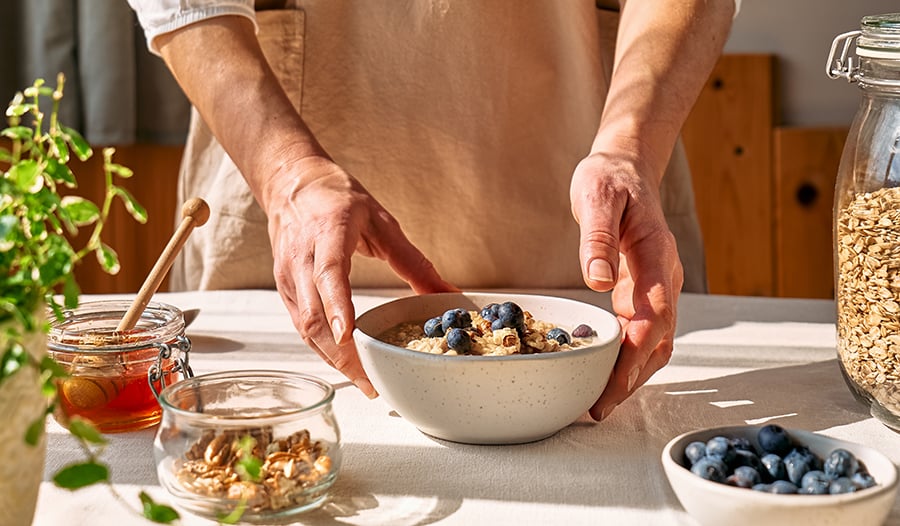20 High-Fiber Foods To Add To Your Diet, According To A Dietitian

Key Takeaways
- Fiber is crucial for digestive health, blood sugar control, and maintaining a healthy weight.
- Women should aim for about 25 grams of fiber per day, and men about 38 grams.
- Legumes (beans, lentils), fruits (berries, pears), vegetables (broccoli, artichokes), and whole grains (oats, quinoa) are some of the best sources.
- A simple way to boost your intake is to add a tablespoon of chia seeds or flaxseeds to your smoothie or yogurt.
What Is Fiber?
Dietary fiber, also known as bulk or roughage, is a type of carbohydrate that the body cannot digest. Fiber is found mainly in fruits, vegetables, nuts, seeds, legumes, and whole grains. Consuming adequate dietary fiber can help support healthy, regular bowel movements, heart health, gut health, and weight management, and may lower your risk of diabetes.
Types of Fiber
Fats, proteins, and carbohydrates are macronutrients that the body breaks down and absorbs for energy. Dietary fiber is unique in that the body cannot digest or absorb it. There are two types of fiber: soluble and insoluble fiber. Some foods contain both soluble and insoluble fibers.
Soluble
Soluble fiber dissolves in water. When dissolved in water, soluble fiber creates a gel-like consistency that improves the shape, size, and texture of stool, helping to ease the passing of bowel movements. Soluble fiber may also support gut health by increasing the beneficial bacteria in the intestines.1
These foods are excellent sources of soluble fiber:
- Oats
- Apples
- Carrots
- Citrus fruits
- Psyllium
- Beans
- Apricots
- Ground Flax Seeds
- Sunflower Seeds
- Sweet Potatoes
- Avocados
Insoluble
Insoluble fiber does not dissolve in water. This type of fiber can accelerate gut transit time, easing the movement of stool through your digestive tract.2
The following foods are rich in insoluble fiber:
- Apples, with skin
- Pears, with skin
- Beans and lentils
- Berries
- Whole-wheat flour
- Wheat bran
- Cauliflower
- Potatoes
- Spinach
- Okra
- Dried apricots, raisins, prunes, and dates
- Almonds
- Walnuts
- Popcorn
What Are The Health Benefits Of Fiber?
Fiber has many health benefits! Some of the health benefits of fiber include:3
- Helps prevent and treat constipation
- Helps slow down the absorption of carbohydrates and sugar, which helps maintain healthy blood sugar levels
- May help reduce the risk of colorectal cancer
- May help manage weight by improving satiety and helping you feel fuller longer
- May reduce the risk of diverticulitis
- Increase microbial diversity in the gut, supporting overall gut health
How Much Fiber Should I Eat Per Day?
The American Heart Association recommends eating 25 to 35 grams of fiber daily from food sources, not supplements. However, because the Standard American Diet is often high in low-fiber and processed foods, the average American adult does not meet this recommendation, consuming an average of only 15 grams of fiber daily.
20 High-Fiber Foods

Eating more fiber could not be easier—or more delicious! But you might be wondering, what foods are high in fiber? Luckily, many foods are naturally high in fiber. Add these high-fiber foods to your shopping list today to boost your fiber intake!
- Oats: Oats contain both insoluble and soluble fiber. One half-cup serving of oats has 4 grams of dietary fiber. Oats also contain a type of soluble fiber known as beta-glucan, which may help reduce LDL “bad” cholesterol levels and improve blood sugar control. Oats are delicious as oatmeal, overnight oats, in baked recipes, and in the form of oat flour for baking.
- Sunflower Seeds: Sunflower seeds are a source of soluble fiber. One quarter-cup serving of sunflower seeds has 3 grams of dietary fiber and 6 grams of protein! Enjoy sunflower seeds on their own, in trail mix, on salads, or on top of yogurt.
- Ground Flax Seeds: One tablespoon of ground flaxseeds has 3.5 grams of fiber along with 2 grams of protein! Choose ground flaxseeds or buy them whole and grind them yourself. Ground flaxseeds are easier to digest and absorb, so your body gets all the nutritional benefits from the seeds. Ground flaxseeds are great on oatmeal, in smoothies, or in baked recipes.
- Carrots: One cup of chopped carrots has 4.6 grams of fiber. Carrots also contain beta carotene, which is converted to vitamin A to support eye health!
- Apricots: One apricot offers 2.1 grams of fiber. Dried apricots are another delicious way to boost fiber intake. Use dried apricots in homemade energy bites, granola, or on top of oatmeal!
- Broccoli: Broccoli is a cruciferous vegetable with many health benefits! One cup of raw broccoli has 2.4 grams of fiber. Enjoy broccoli raw or roasted as a side dish, in a stir-fry, in soups, or diced and added to sauces.
- Lentils: A half-cup of cooked lentils contains 8 grams of fiber and 9 grams of plant-based protein! Lentils are also a great source of iron. Lentils work well in soups and are a yummy plant-based meat alternative for tacos, spaghetti, and burgers! This is one of the best high-fiber foods you can find.
- Avocados: Avocados contain both soluble and insoluble fiber. One serving of avocado, which is a third of the fruit, contains 4.5 grams of fiber. Enjoy a whole avocado, and that’s 13.5 grams of fiber! Avocados are delicious as guacamole, sliced and topped on a salad, as a healthy spread for a sandwich or wrap, added to a smoothie, or even in homemade desserts such as a chocolate avocado pudding!
- Sweet Potatoes: One medium sweet potato has 4 grams of fiber, most of which is soluble fiber! Sweet potatoes also contain potassium, B vitamins, and beta carotene, which convert to vitamin A within the body. Sweet potatoes are delicious baked, mashed, as french fries, as well as diced, roasted, and topped on salads!
- Black Beans: A half-cup serving of black beans has 7.5 grams of fiber along with 7.6 grams of plant-based protein! Black beans are also a source of iron. Black beans are great in soups, tacos, burgers, burritos, topped on a salad, or served as beans and rice!
- Almonds: One 1-ounce serving of almonds—approximately 20 to 24 almonds—contains 3 grams of fiber and 6 grams of protein! Almonds are also rich in the antioxidant vitamin E. Enjoy almonds on their own, in trail mix, on top of oatmeal, yogurt, on top of a salad, and in baked recipes.
- Walnuts: One 1-ounce serving of walnuts—about 7 walnuts—contains 1.9 grams of fiber along with 4.3 grams of protein! Walnuts are also rich in Omega-3 fatty acids, which may support brain and heart health.4,5 Enjoy walnuts on their own, topped on oatmeal or yogurt, in trail mix, on a salad, in a smoothie, or in baked recipes.
- Quinoa: One cup of cooked quinoa contains 5 grams of fiber and 8 grams of plant-based protein! Quinoa is a naturally gluten-free grain. While quinoa is technically a seed, it is cooked like a grain and often referred to as a grain. Enjoy quinoa as a side dish, in a salad, or as hot breakfast cereal.
- Brown Rice: A quarter-cup of dry brown rice has 3 grams of fiber. Rice is also a source of calcium, iron, manganese, and magnesium. Enjoy rice as a side dish, in soups, as a hot breakfast alternative, or in many lunch or dinner recipes.
- Chia Seeds: Just 2 tablespoons of chia seeds contain 9.8 grams of fiber and 4.7 grams of protein! Chia seeds are incredibly nutritious and a source of calcium, iron, magnesium, phosphorus, zinc, vitamin B1, and vitamin B3. Enjoy chia seeds in chia pudding, oatmeal, overnight oats, smoothies, jams, desserts, and baked recipes.
- Pumpkin Seeds: A quarter-cup of pumpkin seeds contains 1.7 grams of fiber as well as 8 grams of plant-based protein! Pumpkin seeds are also rich in antioxidants, iron, zinc, and magnesium. Enjoy pumpkin seeds by the handful, in trail mix, on salads, or in baked recipes!
- Guava: One small guava fruit has 3 grams of fiber! Guava fruits are also rich in antioxidants and vitamin C. Guava is delicious as a fresh fruit, topped on yogurt, oatmeal, in cereal, smoothies, desserts, and more!
- Strawberries: One cup of strawberries offers 2.9 grams of fiber. Strawberries are a low glycemic food packed with vitamin C. Enjoy strawberries as they are, in smoothies, in baked recipes, and in jams or sauces!
- Cauliflower: One cup of chopped raw cauliflower has 2.1 grams of fiber. Cauliflower is also an excellent source of vitamin C, folate (vitamin B9), and vitamin K. Enjoy cauliflower roasted as a side dish, topped on a salad, in mashed potatoes, pizza crust, or diced in tacos, burritos, hamburgers, and more!
- Prunes: Prunes are dried plums and a great way to boost fiber intake! A serving of five prunes provides 3 grams of fiber. Prunes are also a good source of vitamin A, vitamin C, vitamin K, iron, magnesium, copper, and vitamin B6! Enjoy prunes as they are, in trail mix, baked recipes, granola, smoothies, or diced and topped on cereal.
5 Easy Ways To Add More Fiber To Your Day
- Make a smoothie with fruits and vegetables such as bananas, spinach, berries, ground flax seeds, and your favorite protein powder.
- Add spinach to a sandwich.
- Dice vegetables such as zucchini, tomatoes, or mushrooms, and add to your favorite pasta sauce.
- Add lentils or black beans to your taco meat, homemade burgers, or ground meat for spaghetti night.
- Grab a piece of fruit and pair it with nuts or seeds for a snack.
One of the easiest ways to boost your daily intake of fiber is to add more plant-based foods to your plate. Plant-based foods include fruits, vegetables, nuts, seeds, beans, legumes, whole grains, herbs, and spices.
References:
- Guan ZW, Yu EZ, Feng Q. Soluble Dietary Fiber, One of the Most Important Nutrients for the Gut Microbiota. Molecules. 2021 Nov 11;26(22):6802.
- van der Schoot A, Drysdale C, Whelan K, Dimidi E. The Effect of Fiber Supplementation on Chronic Constipation in Adults: An Updated Systematic Review and Meta-Analysis of Randomized Controlled Trials. Am J Clin Nutr. 2022 Oct 6;116(4):953-969.
- Barber TM, Kabisch S, Pfeiffer AFH, Weickert MO. The Health Benefits of Dietary Fibre. Nutrients. 2020 Oct 21;12(10):3209.
- Dighriri IM, Alsubaie AM, Hakami FM, Hamithi DM, Alshekh MM, Khobrani FA, Dalak FE, Hakami AA, Alsueaadi EH, Alsaawi LS, Alshammari SF, Alqahtani AS, Alawi IA, Aljuaid AA, Tawhari MQ. Effects of Omega-3 Polyunsaturated Fatty Acids on Brain Functions: A Systematic Review. Cureus. 2022 Oct 9;14(10):e30091.
- Elagizi A, Lavie CJ, O'Keefe E, Marshall K, O'Keefe JH, Milani RV. An Update on Omega-3 Polyunsaturated Fatty Acids and Cardiovascular Health. Nutrients. 2021 Jan 12;13(1):204.
DISCLAIMER:This Wellness Hub does not intend to provide diagnosis...
















































































 Table of Contents
Table of Contents
















